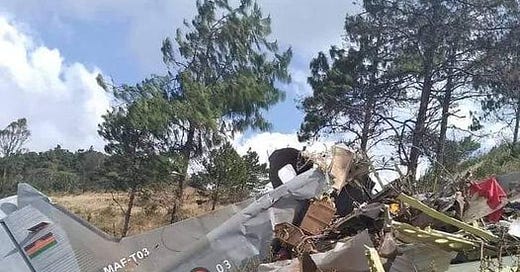Safety Lapses, Outdated Equipment Cited in Malawi VP's Fatal Plane Crash
The report notes that a VOR navigation beacon and NDB radio beacon listed for Mzuzu airport, the flight's destination, "have not existed for at least 15 years."
LILONGWE, Malawi — A German investigation into the June 2024 plane crash that killed Malawi's Vice President Saulos Chilima has revealed a series of safety lapses and outdated equipment, raising serious questions about aviation practices in the southern African nation, writes Winston Mwale.
The interim report, released by Germany's Federal Bureau of Aircraft Accident Investigation (BFU), highlights several critical issues that may have contributed to the tragic accident that claimed nine lives, including that of Vice President Chilima.
Among the most alarming findings was the state of the aircraft's Emergency Locator Transmitter (ELT). Investigators discovered that the device, crucial for locating downed aircraft, was non-functional due to an expired battery.
"It was determined that it was not functioning because its battery had expired in 2004," the report states. This revelation comes two decades after international aviation bodies switched to a new frequency for ELTs, rendering the aircraft's outdated system obsolete.
The Malawi Air Force's response to this finding was equally troubling.
The report quotes officials saying, "for such devices there were no spare parts and no budget for new 406 MHz ELT."
This admission points to broader issues of resource allocation and maintenance within Malawi's military aviation sector.
Further complicating the picture was the discovery that crucial navigation aids listed in Malawi's official aeronautical publications were non-existent.
The report notes that a VOR navigation beacon and NDB radio beacon listed for Mzuzu airport, the flight's destination, "have not existed for at least 15 years."
This discrepancy between published information and reality could have severely impacted the flight crew's ability to navigate safely, especially in the poor weather conditions reported on the day of the crash.
The Dornier 228 aircraft, carrying Vice President Chilima and eight others, crashed into a forested hillside about 34 km southwest of Mzuzu on June 10, 2024.
The plane had departed from Lilongwe's Kamuzu International Airport at 9:16 AM local time, with the flight crew having been on duty since the previous day.
Weather conditions at the destination were reported to be deteriorating, with low cloud ceilings, reduced visibility, and drizzle.
The aircraft's final moments, as recorded by its GPS system, show a series of erratic maneuvers, including rapid altitude changes and multiple turns, suggesting the crew may have been struggling to find a safe approach to the airport.
The report details the aircraft's collision with a tree trunk about 4.5 meters above ground before it struck the hillside.
The impact scattered debris over a wide area, with the fuselage breaking apart and both engines torn from the wings.
In response to these findings, the BFU has issued two safety recommendations.
The first calls on Malawi's Minister of Defence to ensure all military aircraft transporting passengers are equipped with functional Emergency Locator Transmitters.
The second urges the Minister of Transport and Public Works to guarantee that up-to-date information on radio navigation aids is always available to flight crews.
These recommendations highlight the systemic nature of the safety issues uncovered.
The crash has raised questions about the overall state of Malawi's aviation infrastructure, the adequacy of pilot training for adverse weather conditions, and the decision-making processes that led to the use of an ill-equipped aircraft for VIP transport.
As the investigation continues, with a final report expected in the coming months, the tragedy has sparked a national debate about aviation safety and the allocation of resources to critical infrastructure.
The incident serves as a stark reminder of the potentially fatal consequences of neglecting aviation safety standards and the urgent need for modernization in Malawi's aviation sector.




